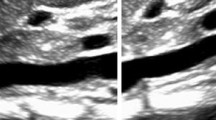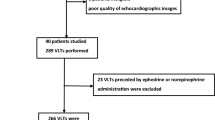Abstract
In critically ill patients, the evaluation of hemodynamic status and the patient’s capacity to respond to a fluid challenge are extremely important. In this context, transthoracic and abdominal ultrasound play a fundamental role for the comprehension of static and dynamic load conditions. Static measurements and dynamic variables give important information for the estimation of intravascular volume status and the assessment of response to intravenous fluid resuscitation. In this chapter, we will examine the following measurement methods: the superior vena cava collapsibility index (ΔSVC), the inferior vena cava size and collapsibility/distensibility index (cIVC/DIVC), the aortic flow variations, the carotid blood flow, and the right internal jugular vein (RIJV) distensibility.
Access this chapter
Tax calculation will be finalised at checkout
Purchases are for personal use only
Similar content being viewed by others
Further Reading
Cecconi M, De Backer D, Antonelli M, et al. Consensus on circulatory shock and hemodynamic monitoring. Task force of the European Society of Intensive Care Medicine. Intensive Care Med. 2014;40:1795–815.
Feissel M, Michard F, Mangin I, Ruyer O, Faller JP, Teboul JL. Respiratory changes in aortic blood velocity as an indicator of fluid responsiveness in ventilated patients with septic shock. Chest. 2001;119:867–73.
Feissel M, Michard F, Faller JP, Teboul JL. The respiratory variation in inferior vena cava diameter as a guide to fluid therapy. Intensive Care Med. 2004;30:1834–7.
Guarracino F, Ferro B, Forfori F, Bertini P, Magliacano L, Pinsky MR. Jugular vein distensibility predicts fluid responsiveness in septic patients. Crit Care. 2014;18:647.
Marik PE, Levitov A, Young A, et al. The use of bioreactance and carotid Doppler to determine volume responsiveness and blood flow redistribution following passive leg raising in hemodynamically unstable patients. Chest. 2013;143:364–70.
Veillard-Baron A, Chergui K, Rabiller A, Peyrouset O, Page B, Beauchet A, Jardin F. Superior vena caval collapsibility as a gauge of volume status in ventilated septic patients. Intensive Care Med. 2012;30:1734–9.
Author information
Authors and Affiliations
Corresponding author
Editor information
Editors and Affiliations
Rights and permissions
Copyright information
© 2019 Springer Nature Switzerland AG
About this chapter
Cite this chapter
Laviola, S., Venni, A., Cantini, S. (2019). The Vena Cava’s and the Great Vessels Ultrasound. In: Sarti, A., Lorini, F. (eds) Textbook of Echocardiography for Intensivists and Emergency Physicians. Springer, Cham. https://doi.org/10.1007/978-3-319-99891-6_12
Download citation
DOI: https://doi.org/10.1007/978-3-319-99891-6_12
Published:
Publisher Name: Springer, Cham
Print ISBN: 978-3-319-99890-9
Online ISBN: 978-3-319-99891-6
eBook Packages: MedicineMedicine (R0)




